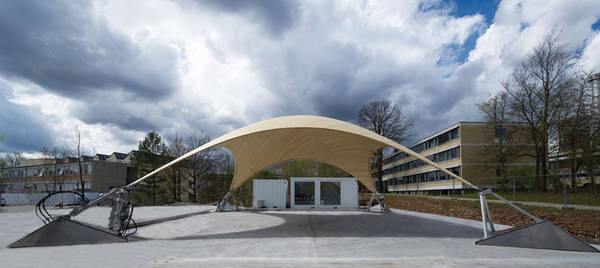In the case of the wooden shell in Stuttgart, this manipulation is achieved via hydraulic drives: these drives are positioned at the support points of the shell and produce movements, which specifically compensate deformations and material strains caused by wind, snow and other loads.
Specific support point movements counteract changing loads (such as through snow or wind) thereby reducing deformation and material tension. Much less material is therefore required for the shell construction compared to conventional, passive construction methods. The load balance is achieved using a Rexroth control system, which has been specially developed for hydraulic drives. The control system is mainly responsible for the complex hydraulic regulation of the shell structure. In this way, the structure is able to react to changes in the load within milliseconds.
In order to actively compensate loads and vibrations, it is first necessary to record or predict these influencing factors precisely. A second step involves calculation and realisation of the required counter-movements in real time. Researchers at the University of Stuttgart have developed simulation models which allow an exact prediction of the behaviour of the structure for this purpose. These take into account material stress as well as vibration behaviour under the influence of static and dynamic loads. The simulation models serve as a basis for development of control concepts, which calculate the required counter-movements for compensation of load and vibration effects according to the recorded measurements. These movements are then implemented precisely by the hydraulic system.
ILEK is a pioneer in research in the field of adaptive systems in the building industry; a first, small-scale prototype was already constructed with the sponsor from Stuttgart some years ago. The core competence of ISYS includes the analysis and specific influence of dynamic systems. For this purpose, the institute develops regulatory structures that create coordinated movements of the supporting structure. Bosch Rexroth is one of the world’s leading specialists in the field of drive and control technologies.
The project is integrated as a functional model in the Research Unit ‘Hybrid Intelligent Construction Elements’ supported by the DGF (German Research Foundation). This Research Unit brings together experts in the fields of mechanical engineering, aerospace engineering, civil engineering and process engineering.
Project participants
- ILEK – Institute for Lightweight Structures and Conceptual Design, University of Stuttgart: Prof. Dr.-Ing. Dr.-Ing. E.h. Werner Sobek, M. Eng. Stefan Neuhäuser, Dipl.-Ing. Christoph Witte, Dr.-Ing. Walter Haase
- ISYS – Institute for System Dynamics, University of Stuttgart: Prof. Dr.-Ing. Oliver Sawodny, Dipl.-Ing. Martin Weickgenannt, Dr.-Ing. Eckhard Arnold
- IBK – Institute for Construction Materials and Building Construction at the University of Applied Sciences RheinMain Wiesbaden: Prof. Leander Bathon
- IfW – Institute for Machine Tools at University of Stuttgart: Prof. Uwe Heisel
- Bosch Rexroth AG, Lohr a. Main: Dr. Johannes Grobe, André Fella



